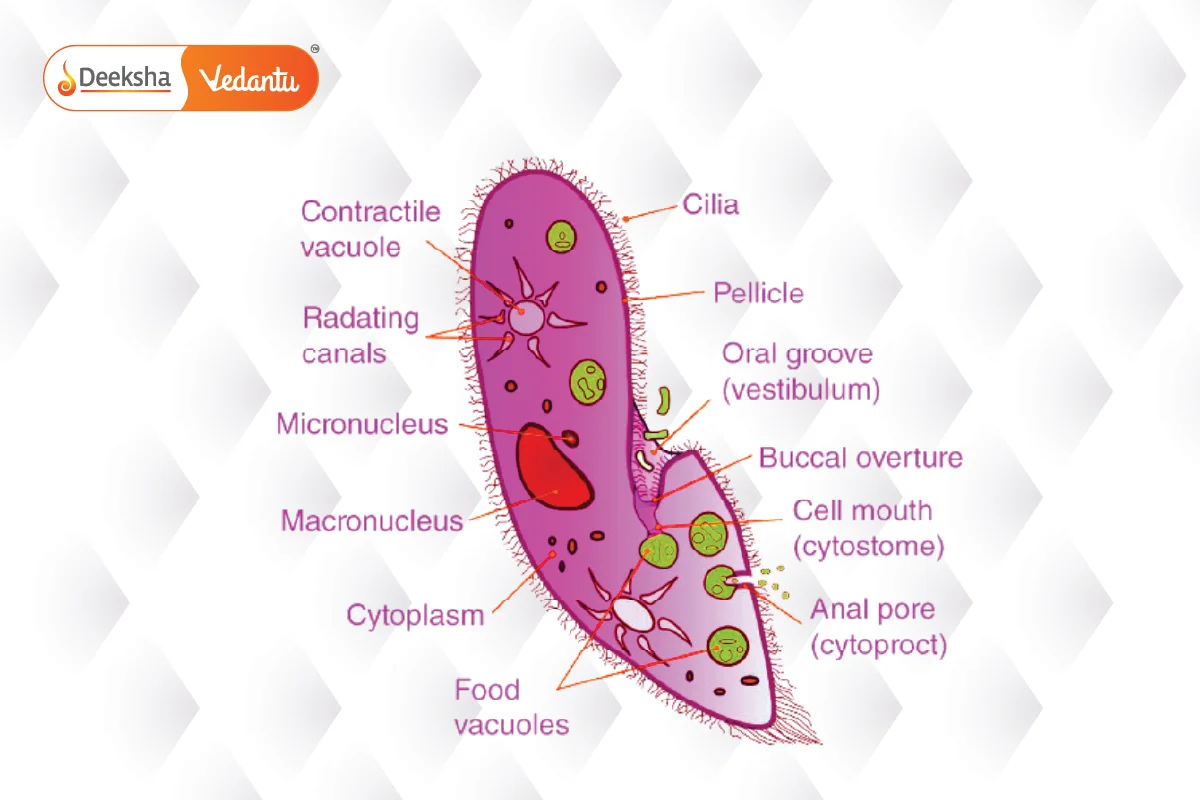What is Paramecium?
Paramecium is a genus of single-celled, ciliated protozoa. These organisms are covered with tiny hair-like structures called cilia. They live in freshwater, marine, and brackish environments, often attached to surfaces. Paramecium primarily reproduce asexually through binary fission, but they also undergo conjugation. They are slipper-shaped and are easy to cultivate, making them useful for biological research.

Paramecium Classification
Paramecium is a unicellular, eukaryotic organism classified under the kingdom Protista and the phylum Ciliophora.
Common species of Paramecium include:
- Paramecium aurelia
- Paramecium caudatum
- Paramecium woodruffi
- Paramecium trichium
Features
- Size: 50 µm to 300 µm
- Shape: Ovoid, slipper, or cigar-shaped
- Pellicle: A protective layer consisting of an outer plasma membrane, inner epiplasm, and alveoli in between
- Cilia: Cover the entire body surface, aiding in movement and feeding
- Protoplasm: Divided into an outer ectoplasm and inner endoplasm
- Trichocysts: Defensive organelles embedded in the ectoplasm
- Nuclei: Contains one or more micronuclei for reproduction and one macronucleus for metabolic activities
- Contractile Vacuoles: Present in varying numbers, used for expelling excess water
- Oral Groove: Midpoint opening leading to the cytostome and gullet for food intake
- Food Vacuoles: Numerous, for digestion
- Anal Pore: Located on the posterior ventral surface for waste expulsion
Paramecium Locomotion
Paramecium moves by coordinating the beating of thousands of cilia, allowing it to rotate and reverse direction when encountering obstacles.
Paramecium Nutrition
Paramecium are heterotrophic and feed on bacteria, algae, yeast, and other microorganisms. They draw food-laden water into their cytostome using cilia, and it is then transported to the gullet and packaged into vacuoles for digestion. Undigested material is expelled through the anal pore.
Some species, like Paramecium bursaria, form symbiotic relationships with green algae, which provide food through photosynthesis. Paramecia with kappa particles can kill other strains of paramecium.
Paramecium Reproduction
- Asexual Reproduction: Through binary fission, where the cell splits into two new cells. Under ideal conditions, paramecia can reproduce up to three times a day.
- Sexual Reproduction: Includes methods like conjugation, autogamy, and cytogamy.
- Conjugation: Two paramecia join and exchange genetic material before dividing into new cells.
- Autogamy: Self-fertilization resulting in a new macronucleus and increased vitality.
- Cytogamy: Two paramecia come into contact without nuclear exchange, leading to rejuvenation and new macronucleus formation.
Paramecia age and die after 100-200 cycles of fission if they do not undergo conjugation, mainly due to DNA damage in the macronucleus.
FAQs
Conjugation in Paramecium is a form of sexual reproduction where two complementary cells exchange genetic material, resulting in genetic variation.
Trichocysts are defensive organelles embedded in the ectoplasm of Paramecium, used for protection.
Nutrient-rich water is drawn into the Paramecium by ciliary movement, enters the oral groove, and is digested within food vacuoles.
Paramecium are heterotrophic and primarily feed on bacteria, algae, yeast, and other microorganisms through a process called holozoic nutrition.
Cilia cover the body of Paramecium and are used for locomotion and feeding by moving water containing food particles into the oral groove.
Yes, Paramecium can reproduce sexually through conjugation, where two cells exchange genetic material, and through less common methods like autogamy and cytogamy.
Paramecium primarily reproduces asexually through binary fission, where a single cell divides into two identical cells.
Paramecium is classified in the kingdom Protista, under the phylum Ciliophora. Common species include Paramecium aurelia, Paramecium caudatum, Paramecium woodruffi, and Paramecium trichium.
Paramecium is a genus of unicellular ciliated protozoa found in various aquatic environments. They are characterized by their slipper shape and are covered with cilia.






Get Social